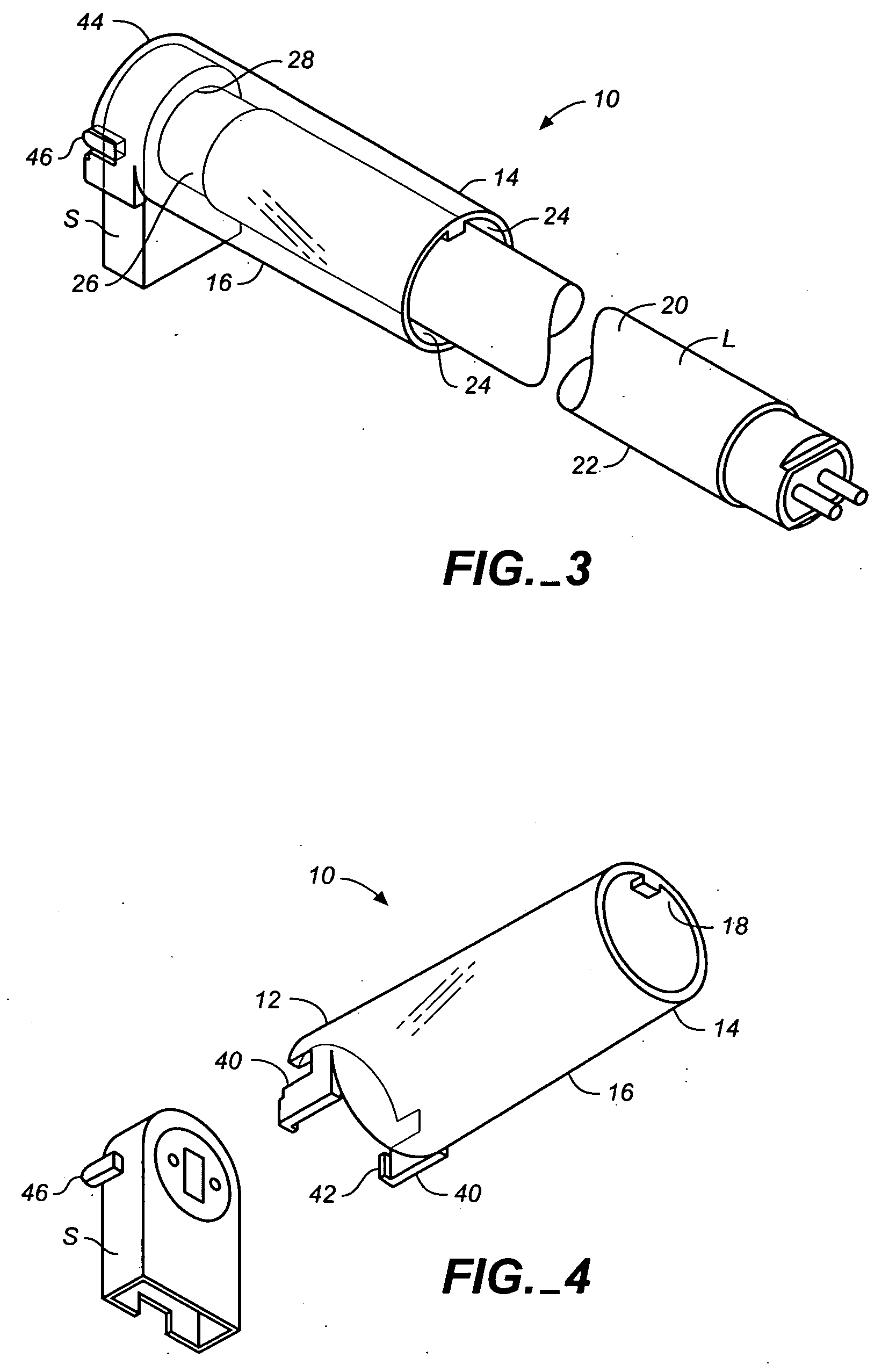Heat retaining sleeve
- Summary
- Abstract
- Description
- Claims
- Application Information
AI Technical Summary
Benefits of technology
Problems solved by technology
Method used
Image
Examples
first embodiment
[0039] The sleeve body 16, as mentioned above, extends from the base end 12 over the lamp body 22. the sleeve body 16 as seen in FIGS. 3-8 is a full cylinder. The full cylinder embodiment is appropriate for use in a direct-indirect lighting fixtures where the lamp body is not crowded by a bottom reflector surface. The full cylinder embodiment completely encircles the lamp body 22 to form a cylindrical heat retaining gap 24 between the inner surface 18 of the sleeve body 16 and the lamp body 22. A downwardly depending projection 50 on the upper part of the distal end 14 of the sleeve body 16 supports the length of the sleeve body over and in concentric alignment with the lamp body in position to form the heat retaining gap 24. This works well in fixtures in which the lamp sockets are upwardly oriented. It will be appreciated that in lighting fixtures in which the lamp sockets are downwardly directed, the projection 50 will be disposed on the opposite side of the sleeve. Those of skil...
second embodiment
[0041] the sleeve comprises a partial cylinder sleeve body 60 seen in FIGS. 9-14. The partial cylinder 60, preferably for use in indirect lighting fixtures characterized by a bottom reflector plate (not illustrated) which tends to crowd the lamp L leaving insufficient room for installation of the full cylinder embodiment of the sleeve body shown in FIGS. 3-8. The partial cylinder sleeve body 60 includes an elongated opening 62 defined by substantially parallel edge portions 64 extending longitudinally along the bottom of the sleeve body 60 adjacent the fixture's bottom reflector plate (not shown). The partial cylinder 60 advantageously cooperates with the bottom reflector plate to form a substantially cylindrical heat retaining gap 66 around most of the lamp body except for a relatively small portion at the bottom. Along each edge portion 64 of the opening is an inwardly extending rib 70 traversing the length of the opening 64. Each rib extends from the inner surface 72 of the sleev...
third embodiment
[0044] a heat retaining sleeve according to the invention is generally indicated by numeral 88 in FIGS. 15-17. In this embodiment, the sleeve, which covers a single lamp L in an indirect lighting fixture and is of a generally square shape, has a sleeve body 89 with a distal end 91 that extends a sufficient distance to reach the hot spot of the lamp. A base end 93 of the sleeve has a downwardly depending projection 90 for fitting into a cooperating aperture (not shown) in the lighting fixture. A tab 92, which extends laterally from the base end, has a hole 96 for accepting a threaded fastener for securing the sleeve 88 to the lighting fixture. The sleeve 88 includes generally parallel side walls 98 and a top wall 100. In alternate embodiments, all or portions of the lengths of the bottom edges 102 of the side walls 98 may be higher to accommodate the elements of the lighting fixture in which the sleeve 88 is mounted, particularly bottom reflector plates which may angle up from the bo...
PUM
 Login to View More
Login to View More Abstract
Description
Claims
Application Information
 Login to View More
Login to View More - R&D
- Intellectual Property
- Life Sciences
- Materials
- Tech Scout
- Unparalleled Data Quality
- Higher Quality Content
- 60% Fewer Hallucinations
Browse by: Latest US Patents, China's latest patents, Technical Efficacy Thesaurus, Application Domain, Technology Topic, Popular Technical Reports.
© 2025 PatSnap. All rights reserved.Legal|Privacy policy|Modern Slavery Act Transparency Statement|Sitemap|About US| Contact US: help@patsnap.com



